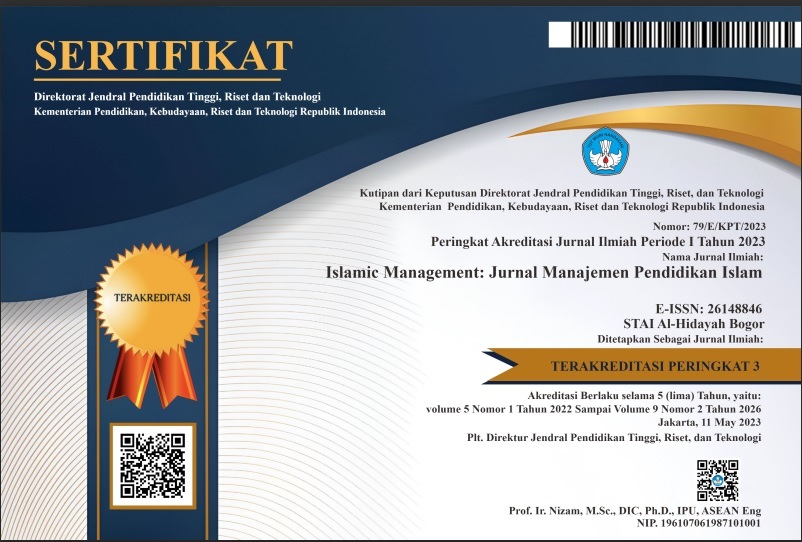WOMEN'S LEADERSHIP MANAGEMENT IN GENDER PERSPECTIVE IN LAMPUNG PROVINCE UNIVERSITIES
DOI:
https://doi.org/10.30868/im.v7i001.7562Keywords:
Gender, Manajemen, Perspektif, Kepemimpinan WanitaAbstract
Gender inequality and injustice in an organization or company, educational institutions included, can still be found. The cause of these differences often occurs due to the influence of gender bias which is still commonly found in reference books, where women are positioned as "second class" society assuming that women's abilities only in domestic affairs and only men who can only play roles as leaders in public affairs. The purpose of this study was to examine and provide an overview of women's leadership in a gender perspective at universities in Lampung Province. This study utilizes qualitative research methods with in-depth interview and documentation as data collection techniques. This study involves the Rector, Vice Rector, Dean and Dean Deputy of various universities in Lampung Province as the subject of the research. The data collection was performed on each different set of times since the depth comprehension through interview is required in this study. The results indicated that female leaders in universities in Lampung Province have a tendency to adopt a feminine-transformational leadership style. It can be seen that up to now, female leaders in universities in Lampung Province have succeeded in improving the performance, morality and performance of the ranks, staff and subordinates which have resulted in brilliant achievements and well-run work programs that have been planned. For further research, it is to be expected that future study could involve more variables and expand the scope of research for the betterness.
References
Afriansyah, Taufieq Renaldi. “‘Deretan Rektor Perempuan Di Indonesia, Ova Emilia Salah Satunya.’” Kompas.Com, May 2022.
Al-Mawardi, Imam. Al-Ahkam As-Sulthaniyyah : Hukum Penyelenggaraan Negara Dalam Syariat Islam. 1st ed. Jakarta: Darul Falah, 2014.
Atmosudirdjo, Prajudi. Administrasi Dan Management Umum. 9th ed. Jakarta: Ghalia Indonesia, 1982.
Bailey, Frederick George. Humbuggery and Manipulation. Cornell University Press, 1988.
Bright, David S, Anastasia H Cortes, Eva Hartmann, Praveen Parboteeah, Jon L Pierce, Monique Reece, A Shah, S Terjesen, J W Weiss, and Others. Principles of Management. Online Access: Center for Open Education Open Textbook Library. OpenStax, Rice University, 2019.
Burns, James M. Leadership. Leadership. Oxford, England: Harper & Row, 1978.
Carter, Nancy, Denise Bryant-Lukosius, Alba DiCenso, Jennifer Blythe, and Alan J Neville. “The Use of Triangulation in Qualitative Research.” Oncology Nursing Forum 41, no. 5 (September 2014): 545–47. https://doi.org/10.1188/14.ONF.545-547.
Djafry, Novianty. “EFEKTIVITAS KEPEMIMPINAN PEREMPUAN DALAM KARIR.” MUSAWA: Journal for Gender Studies 6, no. 1 (2014).
Eagly, Alice H, and Steven J Karau. “Role Congruity Theory of Prejudice toward Female Leaders.” Psychological Review. Eagly, Alice H.: Northwestern U, Dept of Psychology, 2029 Sheridan Road, Swift Hall 313, Evanston, IL, US, 62901-4627, eagly@northwestern.edu: American Psychological Association, 2002. https://doi.org/10.1037/0033-295X.109.3.573.
Efendi, Nur. Islamic Educational Leadership : Praktik Kepemimpinan Di Lembaga Pendidikan Islam. Yogyakarta: Kalimedia, 2017.
Given, Lisa. “The SAGE Encyclopedia of Qualitative Research Methods.” Thousand Oaks, California, 2008. https://doi.org/10.4135/9781412963909.
Hidayah, Siti Nur, and Erni Munastiwi. “Pemimpin Akademik Atau Manajerial? Aspirasi, Harapan Dan Tantangan Perempuan Untuk Menjadi Pemimpin Di Lembaga Pendidikan Tinggi Islam.” PALASTREN Jurnal Studi Gender 12, no. 2 (2019): 455. https://doi.org/10.21043/palastren.v12i2.5628.
Hoare, Joanna, and Fiona Gell. Women’s Leadership and Participation. Women’s Leadership and Participation. Warwickshire: Oxfam GB, 2009. https://doi.org/10.3362/9781780440477.004.
Kemendikbud. “Statistik Pendidikan Tinggi (Higer Education Statistic) 2020.” PDDikti Kemendikbud, 2020, 81–85.
Klenke, Karin. WOMEN IN 2ND EDITION Contextual Dynamics And. 2nd ed. Bingley, UK: Emerald Publishing Limited, 2018.
Locke, Edwin A, and Shelley. Kirkpatrick. The Essence of Leadership : The Four Keys to Leading Successfully / Edwin A. Locke ; and Shelley Kirkpatrick ... [et Al.]. Lexington Books ; Maxwell Macmillan Canada ; Maxwell Macmillan International New York : Toronto : New York, 1991.
Loden, Marilyn. Feminine Leadership, or, How to Succeed in Business without Being One of the Boys. Times Books New York, 1985.
Mertoprawiro, Soedarsono. Kepemimpinan. 1st ed. Semarang Dahara Prize, 1992.
Novita, Mona. “KEPEMIMPINAN PEREMPUAN DALAM PERSPEKTIF PSIKOLOGI DITINJAU DARI ASPEK EMOSI DIRI (Studi Tokoh Rektor Universitas Gadjah Mada Periode 2014-2017).” NUR EL-ISLAM : Jurnal Pendidikan Dan Sosial Keagamaan 5, no. 1 (2018): 16–40. https://doi.org/https://doi.org/10.51311/nuris.v5i1.95.
Rhee, Kenneth, and Tracey Sigler. “Untangling the Relationship between Gender and Leadership.” Gender in Management: An International Journal 30 (April 2015): 109–34. https://doi.org/10.1108/GM-09-2013-0114.
Ruch, Floyd Leon. Incidents of Leadership in Combat. Incidents of Leadership in Combat. Air University, Human Resources Research Institute, 1953.
Shaban, Aya. “Managing and Leading a Diverse Workforce: One of the Main Challenges in Management.” Procedia - Social and Behavioral Sciences 230 (2016). https://doi.org/10.1016/j.sbspro.2016.09.010.
Supardi, and Syaiful Anwar. Dasar-Dasar Perilaku Organisasi. Yogyakarta: UII Press, 2004.
Surahman, Susilo, and Muhammad Munadi. “Kepemimpinan Perempuan Di Perguruan Tinggi: Manajerial Atau Akademik.” Jurnal Kepemimpinan Dan Pengurusan Sekolah 7, no. 1 (2022): 18–26. https://doi.org/10.34125/kp.v7i1.662.
Wijaya, Hengki. Analisis Data Kualitatif Ilmu Pendidikan Teologi, 2018.
Downloads
Published
How to Cite
Issue
Section
Citation Check
License
Copyright (c) 2024 Eti Hadiati, Badrul Kamil, Agus Dwiyanto, Diah Ayu Setianingrum, Setiyo Setiyo

This work is licensed under a Creative Commons Attribution-ShareAlike 4.0 International License.
Authors who publish with this journal agree to the following terms:
- Authors retain copyright and grant the journal right of first publication with the work simultaneously licensed under a Creative Commons Attribution License that allows others to share the work with an acknowledgment of the work's authorship and initial publication in this journal.
- Authors are able to enter into separate, additional contractual arrangements for the non-exclusive distribution of the journal's published version of the work (e.g., post it to an institutional repository or publish it in a book), with an acknowledgment of its initial publication in this journal.
- Authors are permitted and encouraged to post their work online (e.g., in institutional repositories or on their website) prior to and during the submission process, as it can lead to productive exchanges, as well as earlier and greater citation of published work (See The Effect of Open Access).






